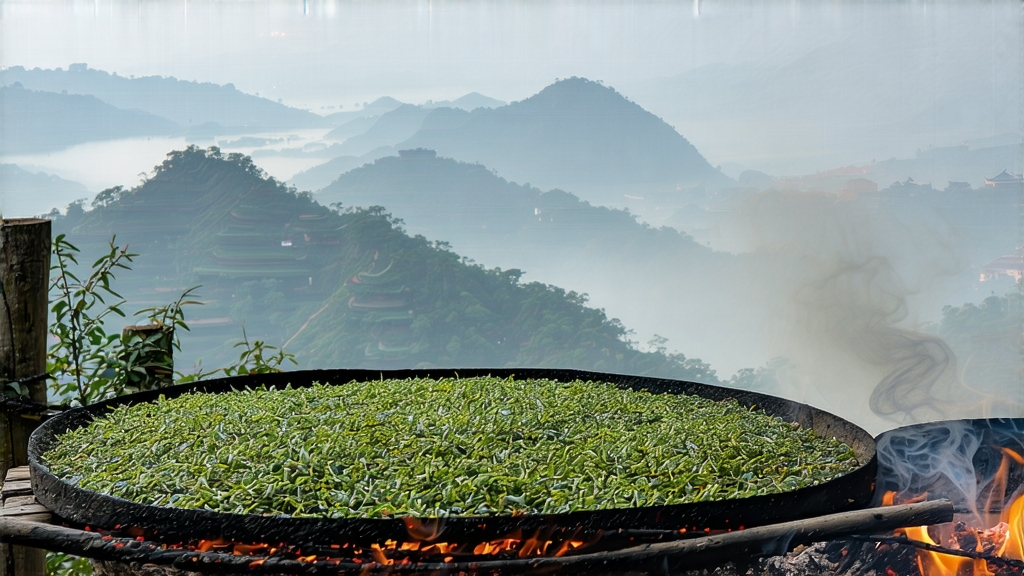
When European tea clippers first rounded the Cape of Good Hope in the late seventeenth century, the cargo that most excited London coffee-house keepers was not silk or porcelain but a small, leathery leaf from the Wuyi massif of northern Fujian. Its liquor glowed like burgundy, its aroma carried the memory of camp-fires, and its taste suggested both sweetness and the tang of resin. That leaf was Lapsang Souchong—today celebrated as the earliest style of black tea ever created, the prototype that taught the world how leaf could be fully oxidised yet remain elegant.
Geography and leaf
The core of authentic Lapsang Souchong lies in Tongmu Guan, a protected enclave inside the Wuyi National Nature Reserve where the altitude climbs quickly from 600 m to 1 500 m. Here, a subtropical monsoon climate collides with mineral-rich, well-drained lateritic soil. The cultivars are mainly small-leaf Xiao Zhong and the indigenous Wuyi Qizhong family; the leaves are picked only between the Qingming festival and the Grain Rain, when the buds have opened into one leaf and a half. Because the reserve bans outside tea being trucked in, every kilo sold as “Tongmu” can be traced to these 68 square kilometres of fog-draped ravines.
Two families, two histories
Local legend credits the invention to a passing Qing-era army that commandeered a tea factory in 1646. To dry the leaf before the troops returned, workers hastily smoked it over fresh pine embers. The accidental batch was bought by Dutch traders, who found European palates enamoured of the campfire nuance. A more scholarly view notes that fully oxidised “hong cha” was already evolving in the Wuyi region during the Ming downfall; the smoke was simply a clever value-add that masked any mustiness on the long sea voyage. Whatever the truth, by 1669 the British East India Company was listing “Bohea Souchong” at 28 shillings a pound—more than twice the price of green Singlo.
Craft: from withering to pinewood
Modern Tongmu production still follows a six-step hand protocol that has changed only in its hygiene, not its heart.
- Outdoor withering: Fresh leaves are laid on bamboo mats in the cool morning shade for two hours, allowing surface moisture to evaporate without heat shock.
- Indoor withering: The leaf is moved onto water-heated bamboo trays kept at 28 °C for a further six to eight hours. Masters judge readiness by the “soft-leather” feel and the disappearance of grassy top-notes.
- Rolling: A light 20-minute roll on cast-iron tables breaks cell walls just enough to release oxidase; the goal is strip-shape rather than the tight balls of oolong.
- Oxidation: In a pine-wood closet at 24 °C and 85 % humidity the leaf rests for three hours. The colour migrates from jade to copper; the aroma shifts from peach to honey.
- Smoking & firing: The critical dual-stage that defines Lapsang. First, the leaf is spread 3 cm deep over a mesh rack set 70 cm above a fire of local Masson pine and a little cypress. The smoke must be cool (38–42 °C) lest it bake the leaf; this “wet smoke” lasts for two hours. Immediately afterwards the tea is pan-fired at 200 °C for 30 seconds to fix the flavour and reduce moisture to 7 %.
- Sorting & resting: Charred fragments are winnowed out, and the tea is left for a minimum of 30 days so that the sharp creosote edges round off into a mellow, tar-and-fruit complexity.
A note on the “unsmoked” trend
Since 2005 a few Tongmu workshops have produced a smoke-free style called Zheng Shan Xiao Zhong, aimed at the domestic Chinese market that prizes the honeyed malt of the leaf itself. Purists argue it is no longer Lapsang, yet both versions share the same cultivar and oxidation protocol; only the absence of pine distinguishes them.
Grades and leaf codes
European importers still use the nineteenth-century SFTGFOP-style acronyms, but within Tongmu the locals speak in Chinese trade codes:
- Zheng Shan (original mountain) – highest pick, smallest leaf, one bud two leaves